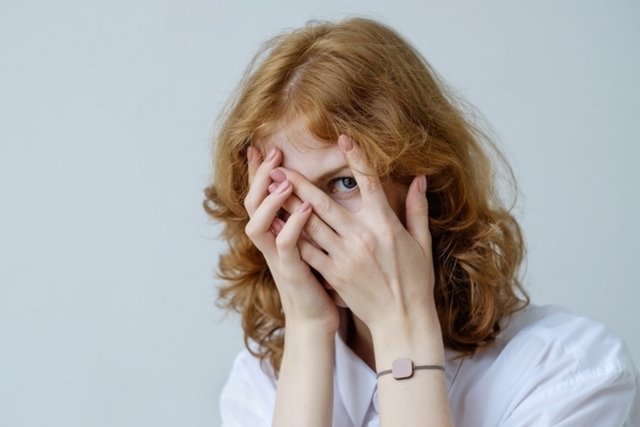Social phobia is a psychological disorder in which a person experiences excessive anxiety and fear when faced with social situations. This usually happens due to the fear of being negatively evaluated for your performance or for what other people will say or think.
Symptoms of this disorder can appear in specific situations, such as meeting unknown people, eating in front of other people, having a job interview or giving a lecture, for example, which can interfere with personal, family and professional life. Social phobia is usually noticed during childhood and adolescence, being more common in women.
Treatment for social phobia is done with psychotherapy, through cognitive-behavioral therapy and exposure therapy, as well as the use of medications that may be recommended by a psychiatrist in some cases, such as alprazolam, paroxetine or propranolol, which help to reduce symptoms of anxiety.

Social phobia symptoms
Symptoms of social phobia include:
- Intense anxiety or fear during situations in which the person is exposed to criticism;
- Avoid most situations where there are many people;
- Fear of being ridiculed;
- Sweating;
- Palpitations:
- Tremors;
- Feeling of shortness of breath;
- Difficulty speaking;
- Nausea;
- Dizziness.
These symptoms can also appear in children, and may be accompanied by crying, episodes of anger or paralysis, for example. Therefore, it is important to be aware of any sign or symptom that could be indicative of social phobia, as this way it is possible for the psychologist to be consulted more quickly and tools to help the person deal with situations can be developed. See more about the main types of phobia.
Don’t ignore the signs your body is giving you!
Social phobia or shyness?
Social phobia and shyness are different conditions. Social phobia is an anxiety disorder that causes intense and constant physical and emotional symptoms, leading to feelings of uncertainty and anguish, fear of rejection and negative judgment from other people, affecting the person’s quality of life, self-esteem , personal and work relationships, which can lead to social isolation.
Shyness, on the other hand, is a behavioral response to social situations that may be uncomfortable for the person, but which does not interfere with quality of life, and is not considered a health problem or a psychological disorder. A shy person can have an active social life and feel motivated to find ways to overcome shyness and act in different social interactions when necessary.
Main causes
The causes of social phobia are not yet fully understood, however some factors can increase a person’s chance of developing this disorder, such as:
- Traumatic past experience in public;
- Family background;
- Child abuse;
- Lack of social skills;
- Negative experiences in social situations, such as swearing and rejection;
- Changing work, school or home.
These situations reduce a person’s confidence, making them doubt their own abilities to perform any role in public.
How the treatment is carried out
Treatment for social phobia is usually guided by a psychologist and begins with cognitive behavioral therapy, in which the person learns to control the symptoms of anxiety, to challenge the thoughts that make them anxious, replacing them with appropriate and positive thoughts, facing real-life situations to overcome their fears and practicing their social skills in a group.
However, when therapy is not enough, the psychologist can refer the person to a psychiatrist, where anxiolytic or antidepressant medications can be prescribed, which will help to obtain better results. However, the ideal is always to try therapy with a psychologist before opting to use medication.
Bibliography
- PELISSOLO, A.; et al. Therapeutic strategies for social anxiety disorder: where are we now?. Expert Rev Neurother. 19. 12; 1179-1189, 2019
- NATIONAL COLLABORATING CENTRE FOR MENTAL HEALTH (UK). LEICESTER (UK): BRITISH PSYCHOLOGICAL SOCIETY (UK). Social Anxiety Disorder: Recognition, Assessment and Treatment. 2013. Available at: <https://www.ncbi.nlm.nih.gov/books/NBK327674/>. Accessed on Nov 16, 2022
- HASSAN, R.; et al. Development of shyness across adolescence: Reactivity, regulation, or both?. Dev Psychol. 57. 3; 421-431, 2021
- LEICHASENRING, F.; LEWEKE, F. Social Anxiety Disorder. N Engl J Med. 376. 23; 2255-2264, 2017
- BADOS, Arturo. SOCIAL PHOBIA. 2017. University of Barcelona.
- American Psychistric Association. Diagnostic and Statistical Manual of mental disorders – DSM-5. 5 ed. Porto Alegre: Artmed, 2014. 202- 208.
- ELIZONDO, Yerlin. SOCIAL ANXIETY DISORDER (SOCIAL PHOBIA). REVISTA MEDICA SINERGIA. 1. 4; 20-24, 2016

Sign up for our newsletter and stay up to date with exclusive news
that can transform your routine!
Warning: Undefined array key "title" in /home/storelat/public_html/wp-content/plugins/link-whisper-premium/templates/frontend/related-posts.php on line 12
Warning: Undefined array key "title_tag" in /home/storelat/public_html/wp-content/plugins/link-whisper-premium/templates/frontend/related-posts.php on line 13




